On Monday, February 1, 2021, much of the northeast was dealing with the effects of a classic nor’easter snowstorm. The snow and wind had begun in the very early morning hours and had been steadily increasing throughout the day. The resulting significant accumulation necessitated installing tire chains on all apparatus to improve traction.
During the height of the storm at 1408 hours, the Stamford Communications Center dispatched Truck 1, Engine 2, and Unit 4 (the deputy chief/shift commander) to Cummings Park at the Marina for a vehicle in the water. Cummings Park is a large city park in the Shippan neighborhood that has several beaches, playing fields, picnic areas, and a marina.
Because of the increased call volume from the storm, Engine 4, which is adjacent to the entrance to Cummings Park, and Rescue 1, to which on-duty divers are assigned, were both tied up on separate incidents. In addition, Stamford Emergency Medical Services (SEMS) Medic 2, the advanced life support (ALS) transporting ambulance, and a medic supervisor (Unit 901) were also assigned to the incident. Dispatch protocol for technical rescue incidents requires a truck company to fill in for Rescue 1 when they are not available. For this response, the closest truck company was Truck 1 at fire headquarters, which is assigned a tower ladder.
RELATED FIREFIGHTER TRAINING
Training Minutes: Rescue Tips from the Tower Ladder Bucket
Ice Rescue: the Leapfrogging Solution
As the initially dispatched units were turning out from their stations, Captain Paul Newman of Rescue 1 advised that they were now available from an elevator incident response in the South End; they would also join the response. Because of the high potential for a scuba operation and the need for additional dive support personnel, Engine 5 from the Woodside Station was also requested for the response. Engine 5 and Rescue 1 are quartered together; their personnel are cross-trained to ride either apparatus.
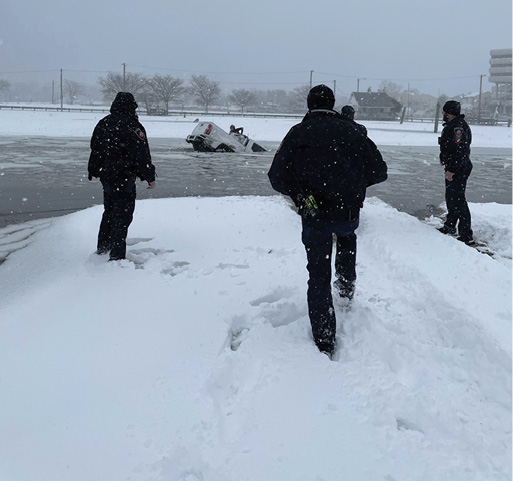
(1) Two Stamford police officers (left and right) and Palmer arrive and make verbal contact with a female occupant (the driver) climbing out of the rear window. (Photos by Frank Docimo Jr. unless otherwise noted.)

(2) Three fire department rescue swimmers approach the truck and assist the female driver, who is standing in the rear cargo bed.
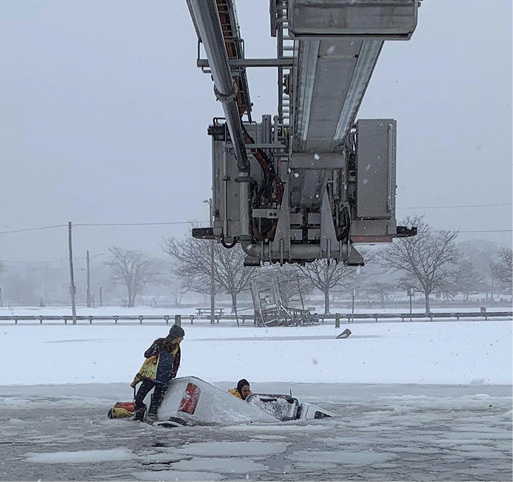
(3) The tower ladder’s basket is maneuvered out and over the rear cargo area of the sinking truck as rescue swimmers attempt to gain entry to rescue the remaining male occupant in the passenger seat. The female driver stands at the rear of the truck’s bed.
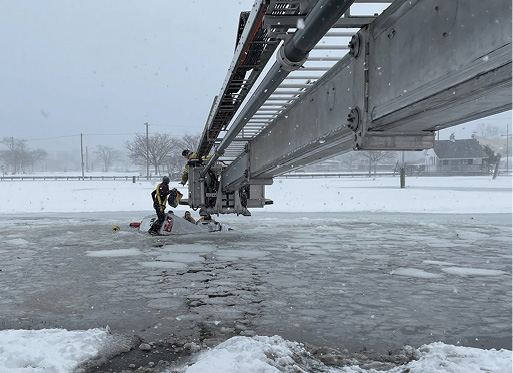
(4) Firefighter Adam Fullilove in the tower ladder reaches down to assist the female occupant into the bucket.
The first Stamford Fire Department (SFD) unit on scene was Frank Docimo Jr., the department’s mechanical supervisor of fleet apparatus, who was only a half-mile away from Cummings Park when this incident was dispatched. He had been clearing snow at the fire department mechanical division.
On arrival, he confirmed that a vehicle was in the water but could not determine if the driver was still in the vehicle. On hearing his report, Matthew Palmer, Unit 4’s deputy chief/shift commander, asked him whether the vehicle was close enough to the shore to use the boom of Truck 1 to reach the vehicle. From Docimo’s vantage point, he believed the boom could reach the sinking vehicle, but the apparatus was going to have to leave the paved parking lot and position on soft snow in a grassy area adjacent to the water.
On numerous occasions, Truck 1 has been deployed to remove injured construction workers from elevated construction projects throughout the city. However, this was the first time that SFD members have had to use the truck to attempt an offshore water rescue.
Command and Tower Ladder Positioning
Palmer arrived on scene at 1413 hours, confirmed that a vehicle (a pickup truck) was in the water, and established Cummings Park Command. Heavy wind-blown snow and a storm-driven high tide challenged arriving personnel in determining the exact distance of the vehicle from the shore. The snow and the frozen harbor had turned the entire surrounding shoreline area into a level, white plain. Because of the height of the tide, the nearby seawall was not visible. The tower ladder’s placement would be crucial to ensure the boom reached the sinking vehicle.
Truck 1’s officer, Captain David Harriott, requested that the area be plowed to make a rough path from the adjacent parking lot toward the waterline. Using the plow blade helped to uncover any hidden hazards in the area and to feel for any unusual softening of the soil resulting from the tide and snow cover. SFD Chief Trevor Roach was also arriving on scene and assisted with guiding Truck 1’s chauffeur, Firefighter Alessio Corrente, into position as close to the waterline as possible. Once the position for Truck 1 was selected, the chauffeur understood that he had only one shot to get it right; if he stopped for any reason in the snow, he may not be able to move again. Fortunately, he was able to position the truck in a spot that allowed his turntable below-grade access and to operate in line with the sinking pickup.
On arrival at the waterline and the closest point to the vehicle, Palmer made verbal contact with the female occupant, who had been able to squeeze through the pickup’s small sliding rear cab window and step into the bed. He asked her if there were any other occupants. She responded that a male friend of hers was in the front passenger seat but he was not in distress. Neither of the occupants exhibited a sense of concern for how dire their situation was. In addition to Palmer at the command post, the chief of department, Assistant Chief Miguel Robles, Assistant Chief Robert Morris, and both of the department’s on-duty safety officers—Captain Victor Rella and Captain Jim Kelley—were arriving and provided operational support.
Tower Ladder Operations
Once the apparatus was placed in position, Harriott ordered the Truck 1 crew to begin immediately setting up on the snow-covered ground. Although the ground was partially frozen, jack pads were deployed to distribute the weight of the apparatus, provide maximum support for the outriggers, and prevent the occurrence of any mishap because of the rig’s position near the seawall. He also ordered Truck 1 Firefighter Chad Titus to don a cold-water suit and prepare to head out to the submerged vehicle. Meanwhile, on Engine 2’s arrival, SFD Lieutenant Steve Bordoni instructed Firefighter Brian Rosero and Firefighter John Colandro to don cold-water suits to assist with the vehicle occupants’ removal. All three firefighters entered the water simultaneously and proceeded out to the vehicle. Harriott decided only one member, Firefighter Adam Fullilove, would remain in the bucket to keep the initial load as light as possible to avoid overloading. He considered the additional weight of the pickup’s occupants and the below-grade operation. Truck 1’s chauffeur was ordered to control all operations at the pedestal to enable more precise movements and provide the operator with a better overall view of the boom, the victims, the vehicle, and the rescue swimmers in the water during whiteout conditions.
As the three firefighters entered the water, the Truck 1 bucket was extended out to the sinking vehicle. A strong offshore wind and outgoing tide continued to slowly move the vehicle away from the shoreline, further complicating the rescue.
Truck 1’s chauffer was able to place the Truck 1 bucket directly above the bed of the sinking vehicle only inches short of full extension of the 95-foot boom. By this time, the female occupant was standing on the rear bumper/tailgate area of the vehicle and was provided with a life ring. Fullilove was able to grab the female occupant from this location and assist her into the Truck 1 bucket.
Stamford (CT) Fire Department
The Stamford (CT) Fire Department (SFD) protects a growing city of 131,000, 35 miles east of New York City. The SFD operates nine engines, three ladders, and one heavy rescue and has one incident command unit/shift commander with an aide at all times. The total shift strength is a minimum of 54 fire officers and firefighters per tour; an additional officer is assigned to the combined communications center. The SFD maintains scuba divers on duty at all times, assigned to Rescue Company 1; a hazardous materials unit; a fireboat; and numerous special units. Five volunteer companies protect the northern half of the city, with several SFD career engine companies providing 24/7 coverage from their stations.
Rescue efforts continued to try to remove the male occupant, who was still in the cab of the truck and was unable to squeeze through the very small 10- × 12-inch rear sliding window of the vehicle. The vehicle was now 80-percent submerged and continued to rapidly sink. The vehicle’s male passenger was now in the back seat and trying to breathe from the only remaining air near the small open rear window.
All three rescue swimmers worked feverishly to break the rear window of the vehicle, which was now the only window above the waterline. As firefighters continued to work, the vehicle quickly disappeared into the black and slushy 32°F water.
Subsurface Valiant Rescue
As the vehicle disappeared below the waterline, Rosero used a halligan bar from Truck 1’s bucket to repeatedly strike the rear window after it was no longer visible underwater. Because of the lack of visibility, the water pressure, and the vehicle’s sinking, it was impossible for him to know if he was having any success with breaking the glass. At the same time, Titus was working on the opposite side of the rear window to try and gain entry and also to monitor his fellow firefighters as they worked nearby.
On the shore, Firefighter Ryan Southard, the initial rescue diver from Rescue 1, was standing ready and was immediately sent into the water to initiate an underwater rescue. A second Rescue 1 member, Firefighter/Diver Joe Micalizzi, was also readied for deployment into the water.
As the vehicle completely submerged into the harbor, Colandro maintained physical contact with the male occupant through the small rear window. Despite extreme personal risk, he maintained his grip on the man’s arm and shoulder and did not let go. As he clung to the man, Rosero made an additional blind underwater strike at the rear truck bed window on the driver’s side and was able to break the glass.
As the glass shattered, Colandro reached down, nearly submerging his head into the water, and made one last pull at the man, who was underwater for 35 seconds. With the rear window now shattered, he was able to pull the male passenger through the narrow opening and above the waterline. Now, the other two rescue firefighters, Titus and Rosero, could assist with stabilizing the man as he came to the surface.

(5) The Truck 1 bucket is lowered into the harbor so rescue swimmers can place the semi-responsive male occupant onto the outer lip.

(6) The other rescued occupant is in the bucket to the right.
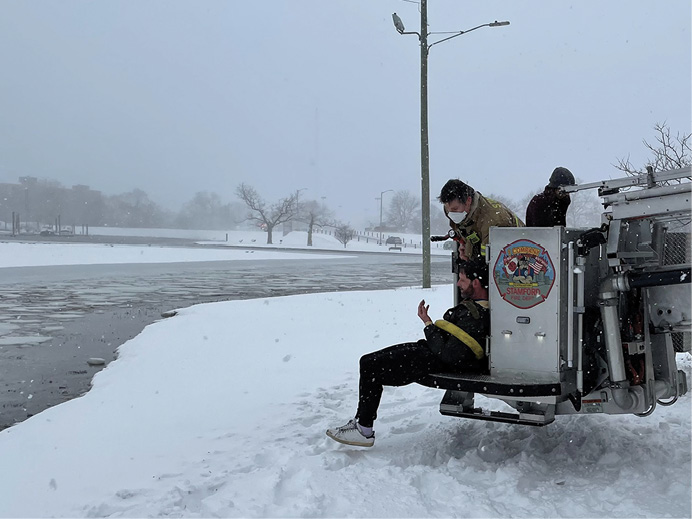
(7) Once the victims are secured into the bucket, the tower ladder is retracted and delivers them to awaiting SEMS paramedics.
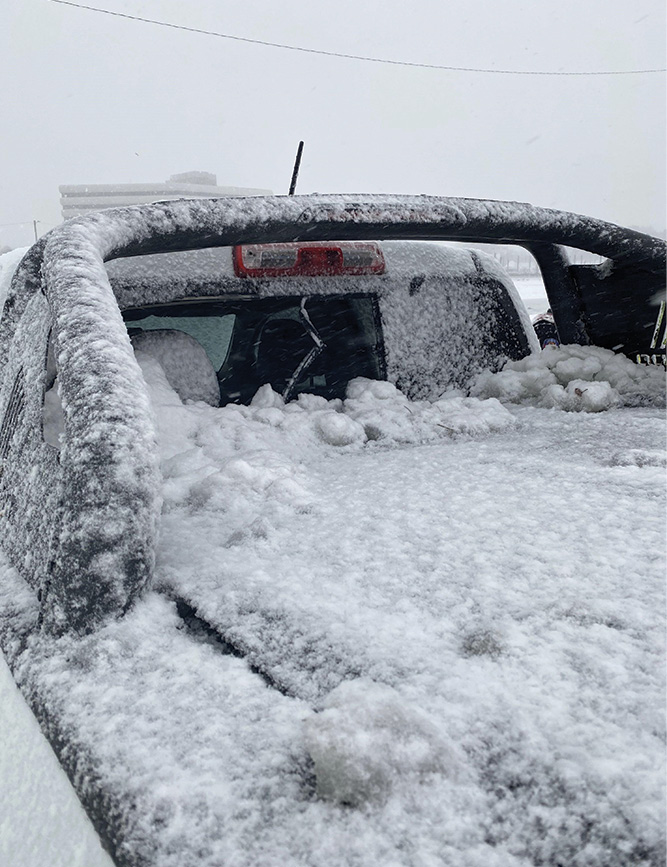
(8) The rear cab window after the pickup was removed from the harbor. (Photos 8-9 by Matthew Palmer.)
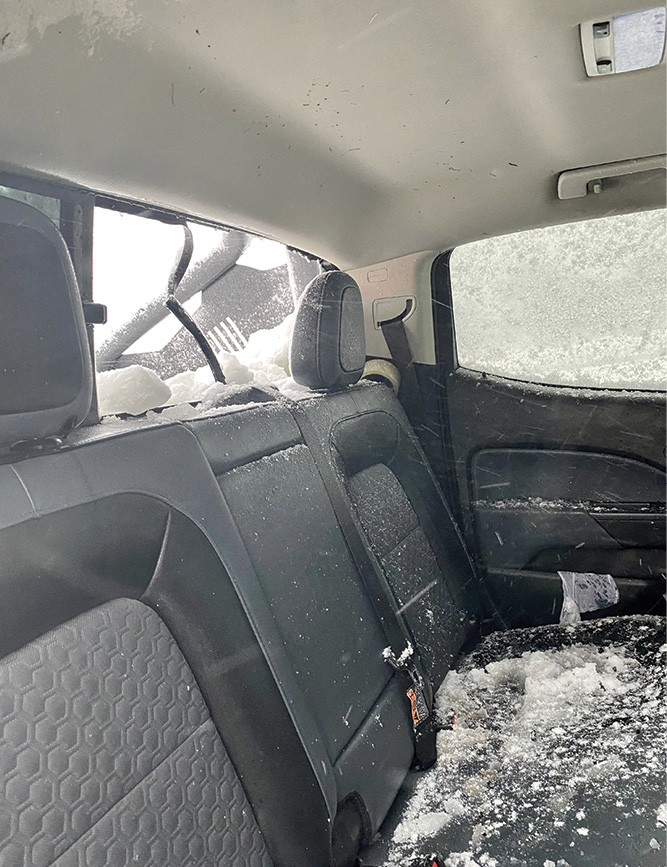
(9) The center sliding window opening was 12 inches wide × 10 inches tall. The fixed window to the right was shattered to pull the male occupant through after he was underwater for 35 seconds.
With the male occupant free from the vehicle and on the surface of the water, all three rescue swimmers guided him to the bucket of the tower ladder. Rather than have the rescue swimmers try and lift the semiconscious male onto the outer lip of the bucket, the chauffeur was instructed to lower the bucket directly into the icy salt water. In doing so, the rescue swimmers were able to minimize the time and effort required to get the man onto the lip. Once into position, Fullilove was able to securely hold onto the man as the chauffeur swung the boom back onto the shoreline. Once on shore, both victims were transferred to awaiting SEMS paramedics to be treated for their injuries and exposure to the frigid water.
At 1421 hours, Cummings Park Command radioed Fire Dispatch that both occupants had been removed using the tower ladder and were now on shore. The total time from the arrival of the first fire company at the scene to removal of both occupants to the shore was less than eight minutes.
Lessons Learned
The successful rescue of both occupants during this storm demonstrates the talents and capabilities of the members and the department. However, we learned several valuable lessons through this incident that we will use to improve future rescue and water-based operations.
- Severe weather will impact any organization’s ability to operate. With adverse conditions and increased incident volume, having support vehicles to assist in moving apparatus or resources is critical. The mechanical supervisor’s assistance with his department service vehicle and plow permitted Truck 1’s ideal positioning for the rescue. Otherwise, it might have gotten stuck, limiting access for other apparatus and personnel.
- Radio communications can be a challenge at almost every large incident. Days prior to this incident, the city’s digital radio system underwent a monumental shift to a statewide network. This included all new portable radios for fire, police, and EMS units. The new radios and system worked flawlessly during this operation, but it is imperative that all agencies understand and use assigned and common tactical radio frequencies.
- Safety for all first responders is paramount during this type of high-risk/low-frequency operation. Personnel from all responding agencies must maintain awareness of their surroundings and the possibility of entering frigid waters or exposure to the elements. Any member working within 25 feet of the shoreline must wear proper personal protective equipment and flotation devices.
- Using a tower ladder on a snow-covered grassy surface within a few feet of the waterline is far from what many manufacturers would recommend for setup. Defending this type of operation would be very hard if it had been a training exercise or an animal rescue. However, “risk a lot to save a lot” applied in this case, and the tower ladder’s positioning and firefighters’ actions resulted in a successful rescue of the two persons from the vehicle and the frigid waters.
- To remove the semi-responsive male occupant, the tower ladder’s bucket was lowered directly into the salt water. This tower ladder has a step on the outside of the bucket that allowed rescuers to place the man on while the boom was raised and swung over to the shore. Not all aerial buckets have this feature. Personnel must become familiar with methods for removing unconscious or incapacitated victims using their specific aerial device. In addition, the salt water is very corrosive and could potentially damage electrical components and overload the aerial device. If contact with salt water is possible, departments should contact their dealer or vendor for guidance on properly flushing components and to evaluate after. It may be best to remove the apparatus from service and have the dealer evaluate it directly.
- Once both occupants had been safely moved to the shore and into the care of SEMS personnel, Rescue 1 and Engine 5 members remained at the scene to assist Stamford police in removing the submerged vehicle. The truck had come to rest in approximately 15 feet of water and was not visible from the surface or from the shore. Divers had been readied as the vehicle was sinking. They worked with a local tow company to immediately remove the vehicle from the harbor. This operation provided a good training opportunity for divers and line tenders. It further strengthened our working relationship with the police department since it enabled them to quickly inspect the vehicle as part of their investigation.
Any successful operation rarely depends on one member; your team’s value is often stated but may not always be quantified. In this incident, all initial and later-arriving companies contributed to avert a potential tragedy. Any change in any responding company’s actions would have meant further delay for a situation that had run out of time when the vehicle completely submerged.
With this incident, it is important to review and share the lessons learned to improve responses to similar events in the future. This successful rescue validates the SFD’s long-standing investment in the training and equipment for its cold-water rescue and scuba diving programs as well as the commitment and dedication of its members.
Matthew Palmer is a deputy chief with the Stamford (CT) Fire Department, where he has served 26 of his 34 years in the fire service. Assigned as the shift commander for Group 2, Palmer previously served as the deputy chief of training and the director of the Stamford Regional Fire School. He has a bachelor’s degree in public safety administration from Charter Oak State College and is a certified fire officer IV and fire instructor.
David Harriott is a captain with the Stamford (CT) Fire Department, assigned to Truck 1, Group 1. He has served 26 of his 35 years in the fire service with the department. Harriott has a bachelor’s degree in management from Pace University and is a certified fire officer II and fire instructor.

